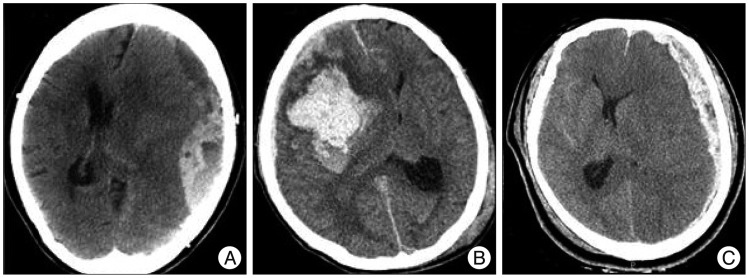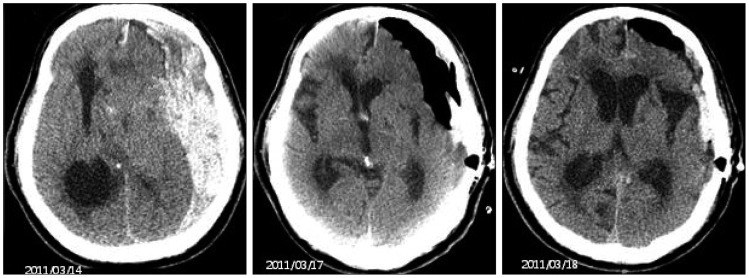1. Andrews PJ, Sleeman DH, Statham PF, McQuatt A, Corruble V, Jones PA, et al. Predicting recovery in patients suffering from traumatic brain injury by using admission variables and physiological data : a comparison between decision tree analysis and logistic regression. J Neurosurg. 2002; 97:326–336. PMID:
12186460.

2. Cagetti B, Cossu M, Pau A, Rivano C, Viale G. The outcome from acute subdural and epidural intracranial haematomas in very elderly patients. Br J Neurosurg. 1992; 6:227–231. PMID:
1632921.

3. Chamoun RB, Robertson CS, Gopinath SP. Outcome in patients with blunt head trauma and a Glasgow Coma Scale score of 3 at presentation. J Neurosurg. 2009; 111:683–687. PMID:
19326973.

4. Chaudhuri K, Malham GM, Rosenfeld JV. Survival of trauma patients with coma and bilateral fixed dilated pupils. Injury. 2009; 40:28–32. PMID:
19070839.

5. Frosch DL, Kaplan RM. Shared decision making in clinical medicine : past research and future directions. Am J Prev Med. 1999; 17:285–294. PMID:
10606197.

6. Hahm KH, Lee I. Biomedical ethics policy in Korea : characteristics and historical development. J Korean Med Sci. 2012; 27(Suppl):S76–S81. PMID:
22661876.
7. Honeybul S, Gillett GR, Ho KM, Lind CR. Neurotrauma and the rule of rescue. J Med Ethics. 2011; 37:707–710. PMID:
21947803.

8. Honeybul S, Ho K, O'Hanlon S. Access to reliable information about long-term prognosis influences clinical opinion on use of lifesaving intervention. PLoS One. 2012; 7:e32375. PMID:
22384231.

9. Honeybul S, Ho KM, Lind CR, Gillett GR. Surgical intervention for severe head injury : ethical considerations when performing life-saving but non-restorative surgery. Acta Neurochir (Wien). 2011; 153:1105–1110. PMID:
21347576.

10. Honeybul S, O'Hanlon S, Ho KM. Decompressive craniectomy for severe head injury : does an outcome prediction model influence clinical decision-making? J Neurotrauma. 2011; 28:13–19. PMID:
20979568.

11. Hukkelhoven CW, Steyerberg EW, Rampen AJ, Farace E, Habbema JD, Marshall LF, et al. Patient age and outcome following severe traumatic brain injury : an analysis of 5600 patients. J Neurosurg. 2003; 99:666–673. PMID:
14567601.

12. Kotwica Z, Saracen A. Severe head injuries in the elderly. Hygeia Public Health. 2010; 45:197–201.
13. Kuhne CA, Ruchholtz S, Kaiser GM, Nast-Kolb D. Working Group on Multiple Trauma of the German Society of Trauma. Mortality in severely injured elderly trauma patients--when does age become a risk factor? World J Surg. 2005; 29:1476–1482. PMID:
16228923.

14. Lingsma HF, Roozenbeek B, Steyerberg EW, Murray GD, Maas AI. Early prognosis in traumatic brain injury : from prophecies to predictions. Lancet Neurol. 2010; 9:543–554. PMID:
20398861.

15. Mak CH, Wong SK, Wong GK, Ng S, Wang KK, Lam PK, et al. Traumatic brain injury in the elderly : is it as bad as we think? Curr Transl Geriatr Exp Gerontol Rep. 2012; 1:171–178. PMID:
24014175.
16. MRC CRASH Trial Collaborators. Perel P, Arango M, Clayton T, Edwards P, Komolafe E, et al. Predicting outcome after traumatic brain injury : practical prognostic models based on large cohort of international patients. BMJ. 2008; 336:425–429. PMID:
18270239.

17. Mushkudiani NA, Engel DC, Steyerberg EW, Butcher I, Lu J, Marmarou A, et al. Prognostic value of demographic characteristics in traumatic brain injury : results from the IMPACT study. J Neurotrauma. 2007; 24:259–269. PMID:
17375990.

18. Patel HC, Bouamra O, Woodford M, Yates DW, Lecky FE. Clinical article : mortality associated with severe head injury in the elderly. Acta Neurochir (Wien). 2010; 152:1353–1357. discussion 1357. PMID:
20437280.

19. Pilitsis J, Atwater B, Warden D, Deck G, Carroll J, Smith J, et al. Outcomes in octogenarians with subdural hematomas. Clin Neurol Neurosurg. 2013; 115:1429–1432. PMID:
23428139.

20. Rennie SC, van Rij AM, Jaye C, Hall KH. Defining decision making : a qualitative study of international experts' views on surgical trainee decision making. World J Surg. 2011; 35:1214–1220. PMID:
21472366.

21. Schaller C, Kessler M. On the difficulty of neurosurgical end of life decisions. J Med Ethics. 2006; 32:65–69. PMID:
16446408.

22. Steyerberg EW, Mushkudiani N, Perel P, Butcher I, Lu J, McHugh GS, et al. Predicting outcome after traumatic brain injury : development and international validation of prognostic scores based on admission characteristics. PLoS Med. 2008; 5:e165. discussion e165. PMID:
18684008.
23. Stocchetti N, Paternò R, Citerio G, Beretta L, Colombo A. Traumatic brain injury in an aging population. J Neurotrauma. 2012; 29:1119–1125. PMID:
22220762.

24. Tokutomi T, Miyagi T, Ogawa T, Ono J, Kawamata T, Sakamoto T, et al. Age-associated increases in poor outcomes after traumatic brain injury : a report from the Japan Neurotrauma Data Bank. J Neurotrauma. 2008; 25:1407–1414. PMID:
19086809.

25. Turgeon AF, Lauzier F, Simard JF, Scales DC, Burns KE, Moore L, et al. Mortality associated with withdrawal of life-sustaining therapy for patients with severe traumatic brain injury : a Canadian multicentre cohort study. CMAJ. 2011; 183:1581–1588. PMID:
21876014.






 PDF
PDF ePub
ePub Citation
Citation Print
Print








 XML Download
XML Download